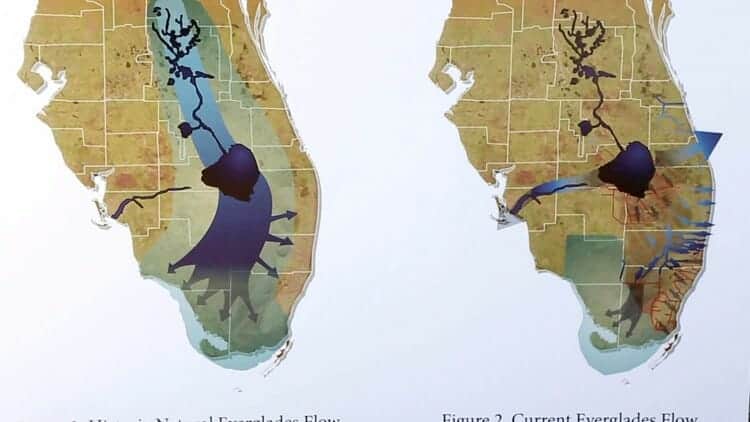

(Above) A diagram from 2016 shows water flow in South Florida. (Allen Eyestone / The Palm Beach Post)
Florida’s freshwater heart is choking on nutrient-laden inflows from the north, south and east this summer, but Treasure Coast waterways have so far been spared the damaging Lake Okeechobee discharges that seeded 2016’s widespread algae bloom. In a move that hasn’t been made since 2014, the Army Corps of Engineers is letting Martin County’s St. Lucie Canal run into Lake Okeechobee to increase lake levels lowered by spring drought.
Water from the canal, also called the C-44, comes from the east. It’s a reverse of what happened last summer where water from the lake went through the canal into the St. Lucie estuary. Trickling through row crops, golf courses and some residential areas, the canal water has contained as much as two times the amount of phosphorous this month than what is considered normal, according to the South Florida Water Management District. The corps estimates 386 million gallons per day of canal water went into the lake during a 52-day period beginning June 5. At the same time, Kissimmee […]
Full article appeared in the Palm Beach Post, but appears to no longer be available online. —Ed.
Florida: FWC to suspend aquatic spraying
NOAA: 40% of Lake Okeechobee covered in harmful algae
Petition against spraying herbicide to be heard by FWC
Environmental activist Erin Brockovich on water releases from Lake Okeechobee
Clean water is essential for life, yet millions of Americans unknowingly consume contaminants through their…
Human brains contain higher concentrations of microplastics than other organs, according to a new study, and the…
From the Office of the Governor: In anticipation of a multi-day, significant atmospheric river in Northern California,…
From Governor Newsom: Scientists, water managers, state leaders, and experts throughout the state are calling…
Photo: A harmful algal bloom in Milford Lake, Kansas, made the water appear bright green.…
An expanded plastic foam coffee cup is at a donut shop in Monterey Park, California.…